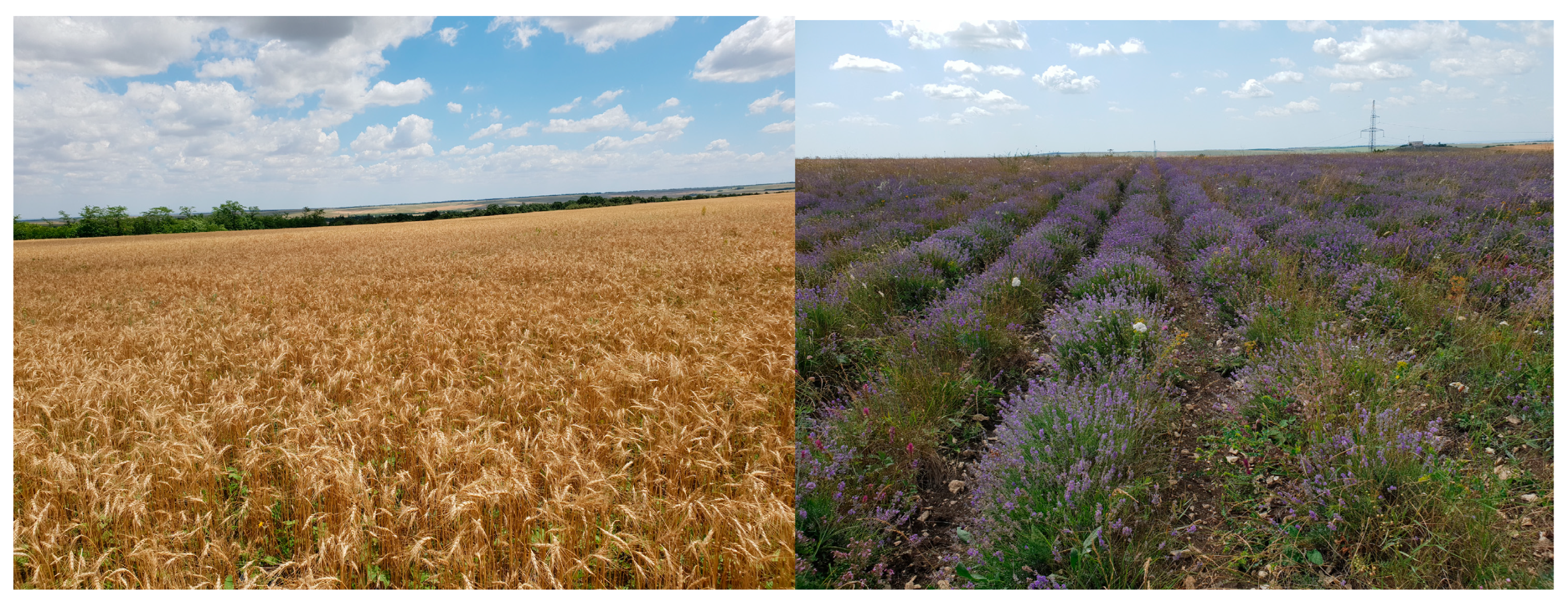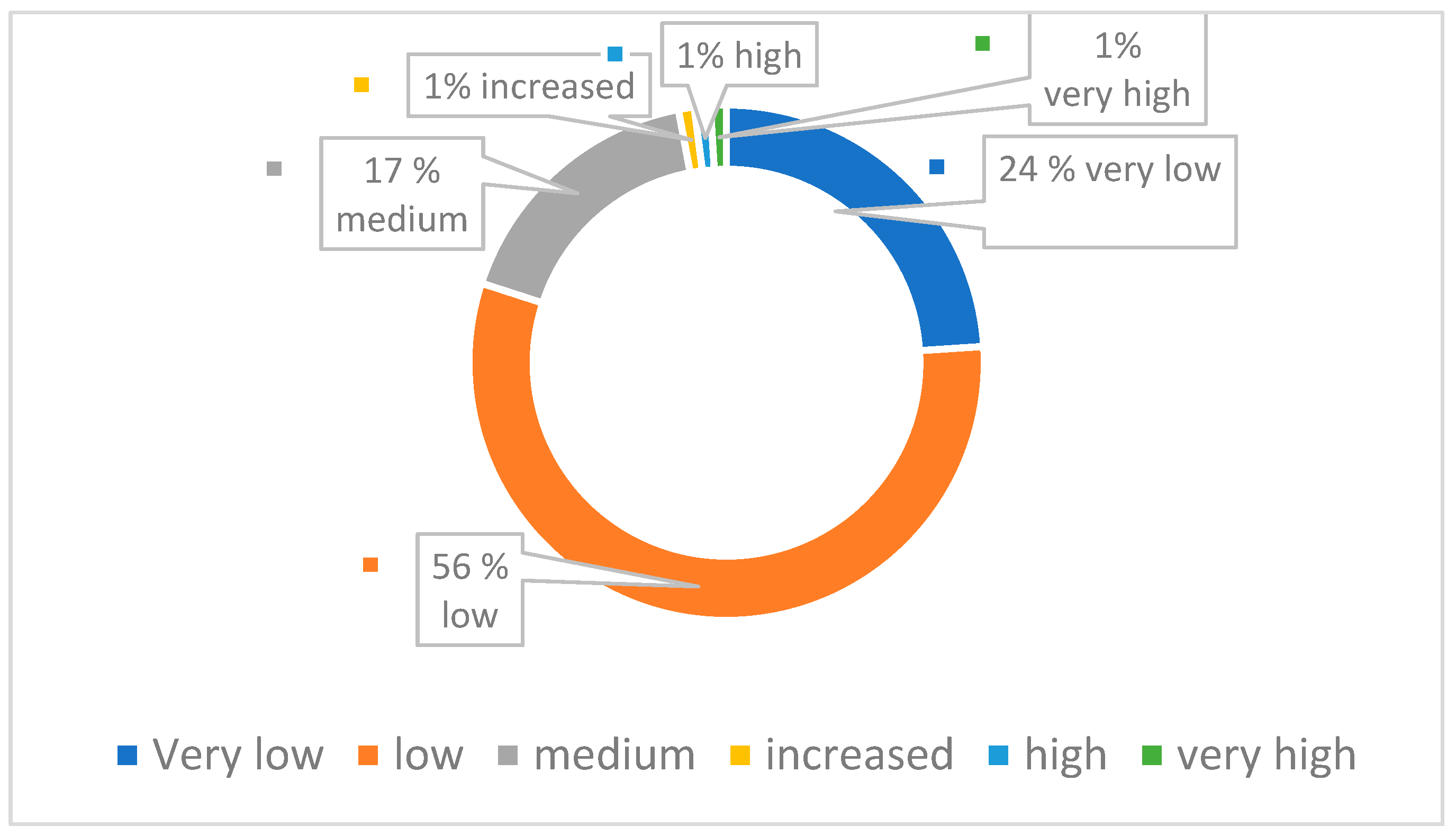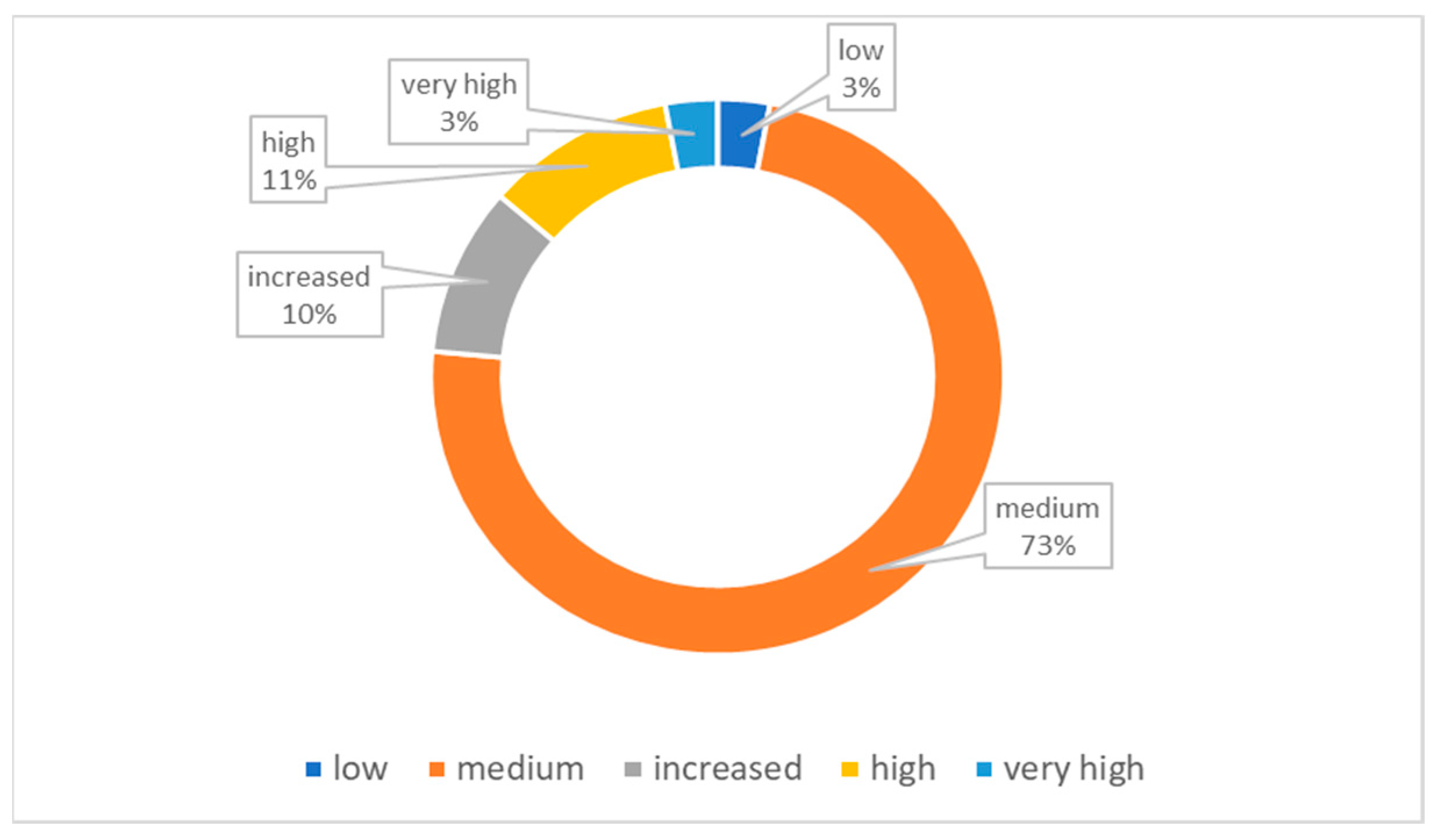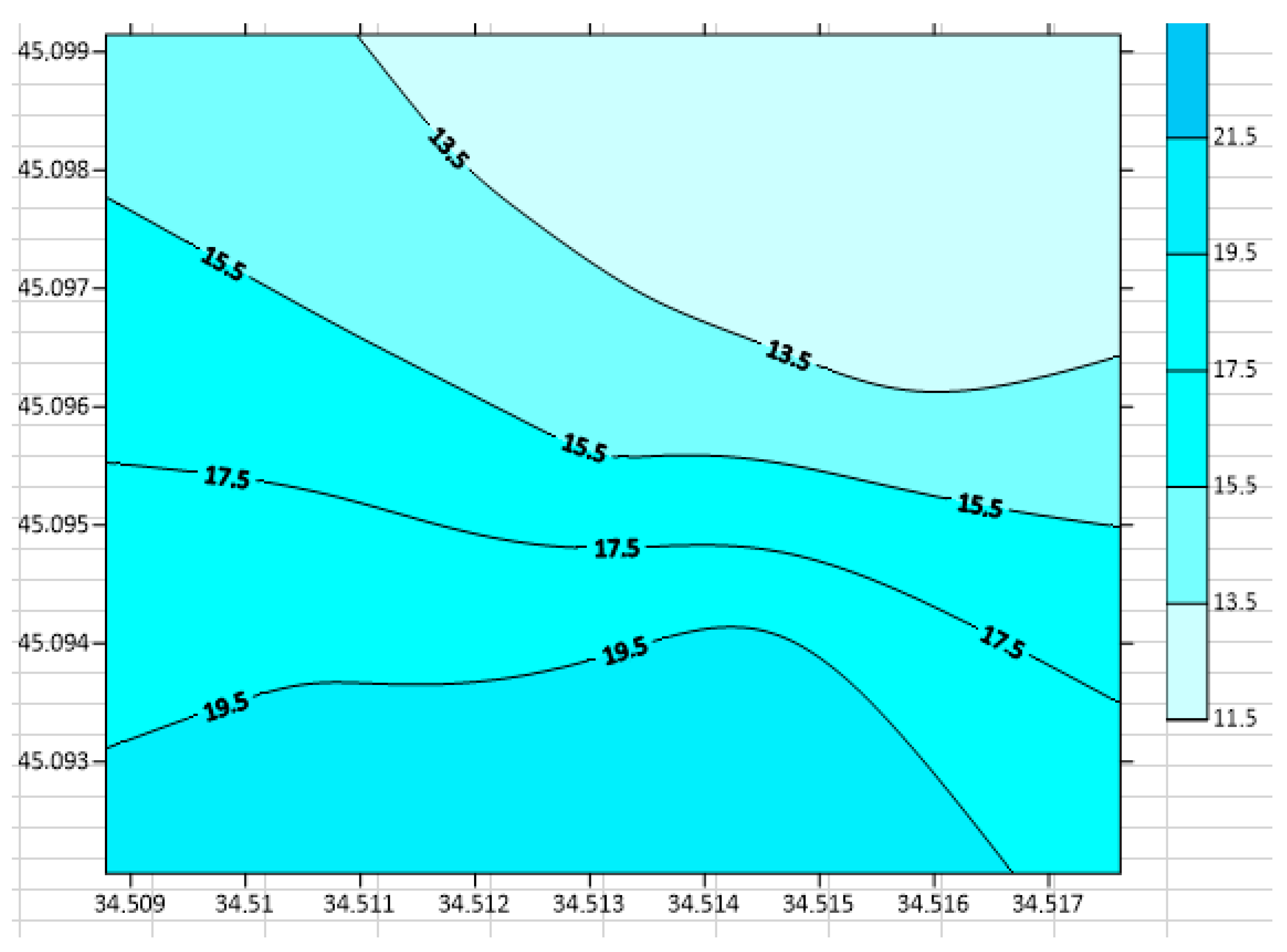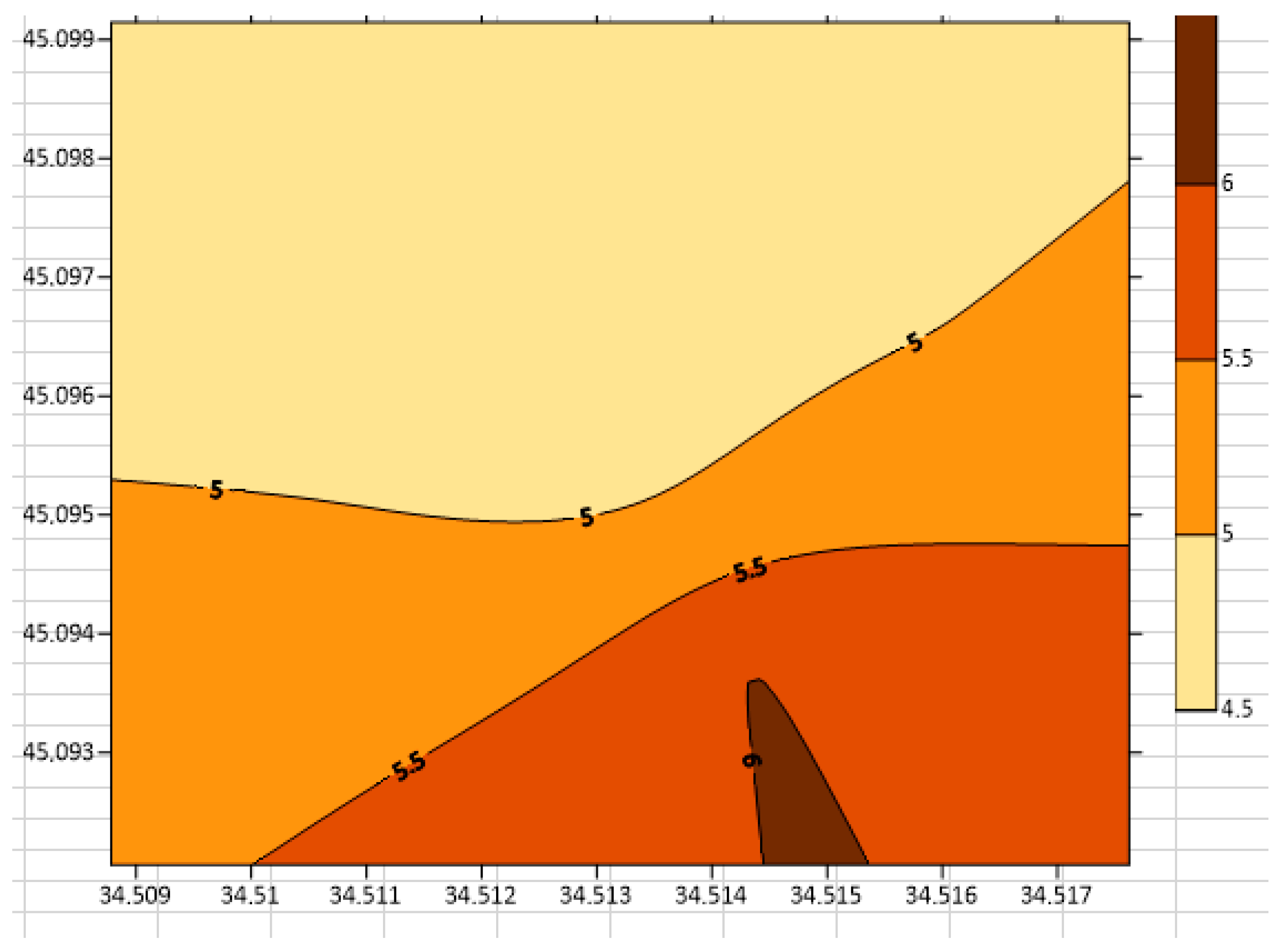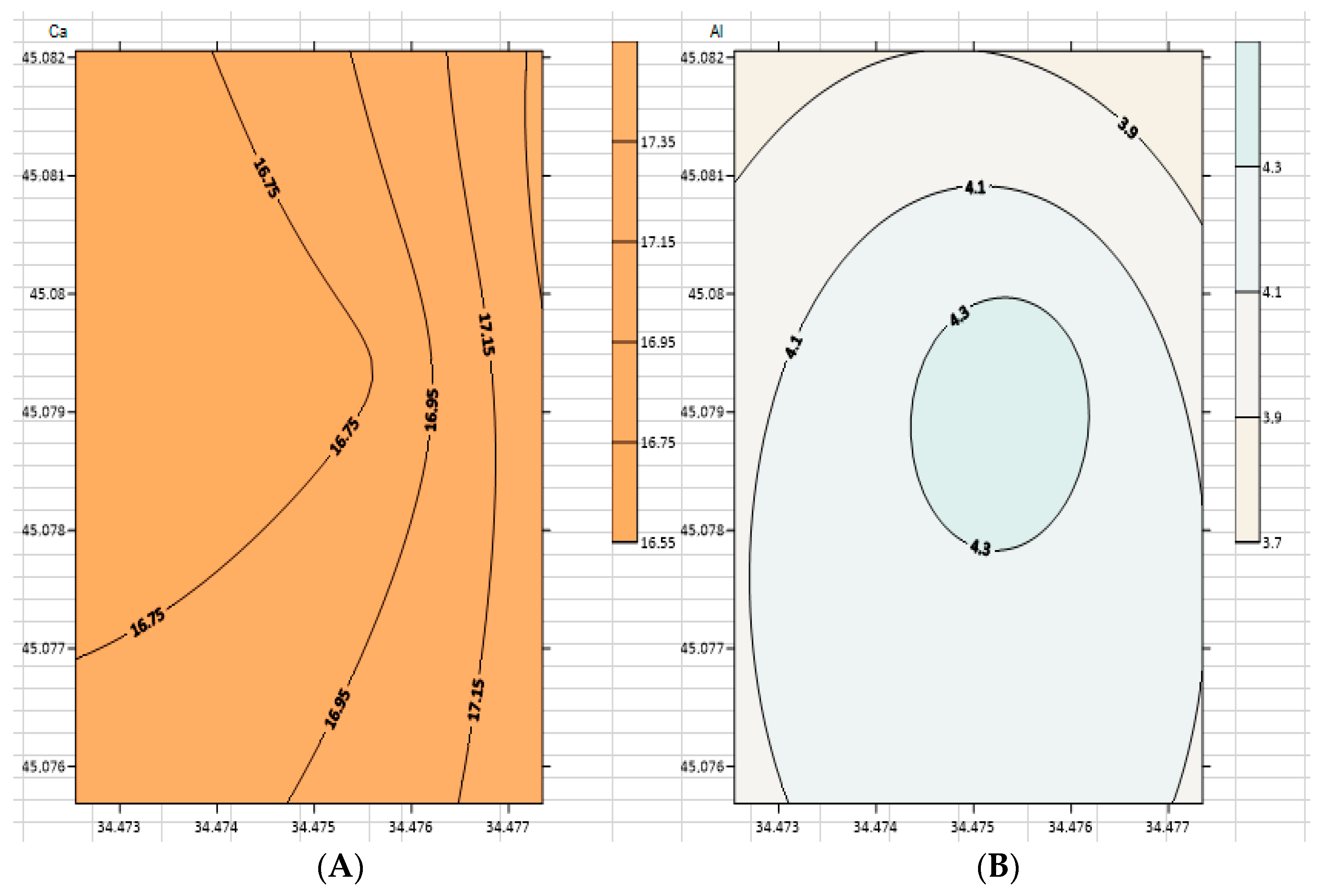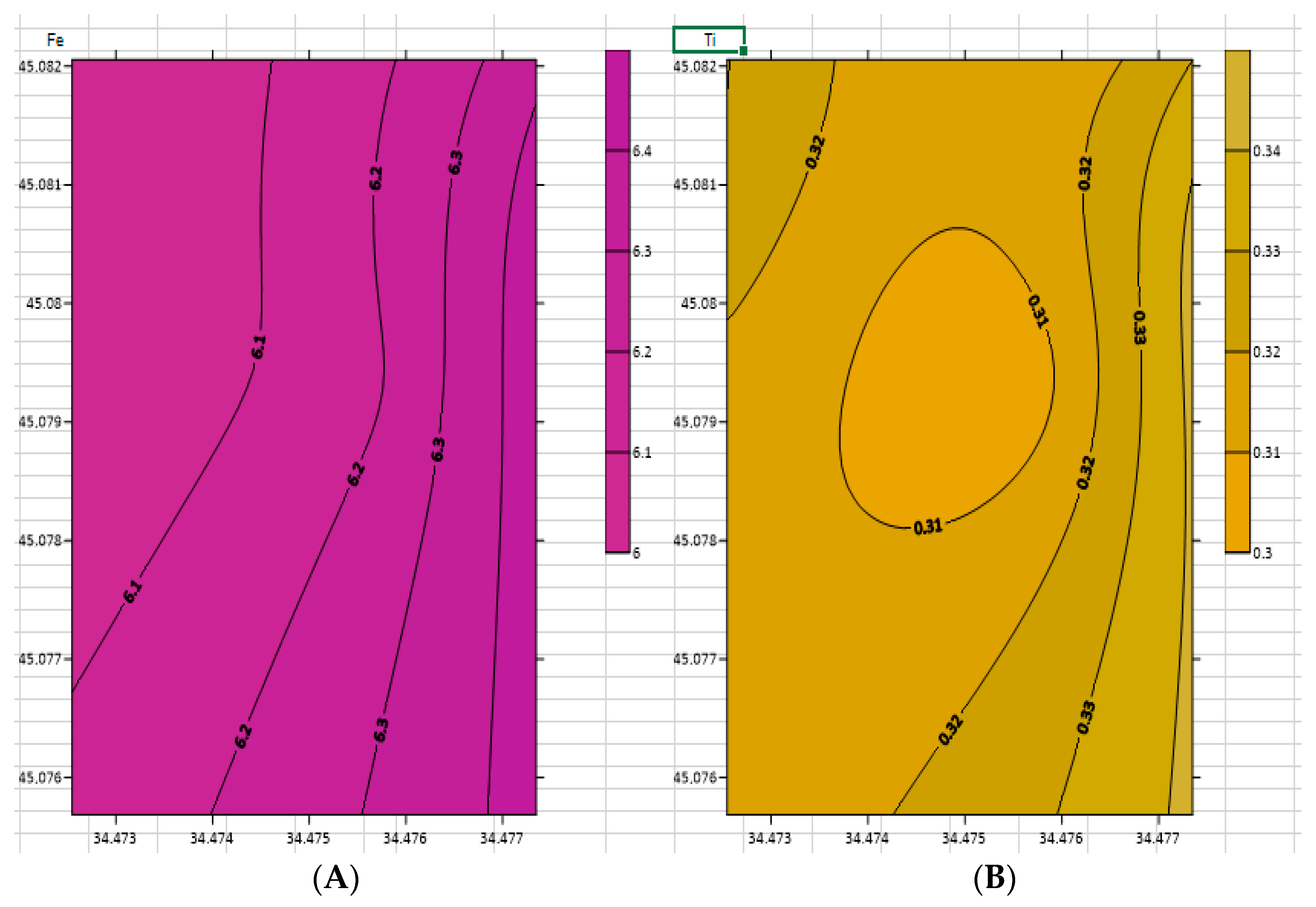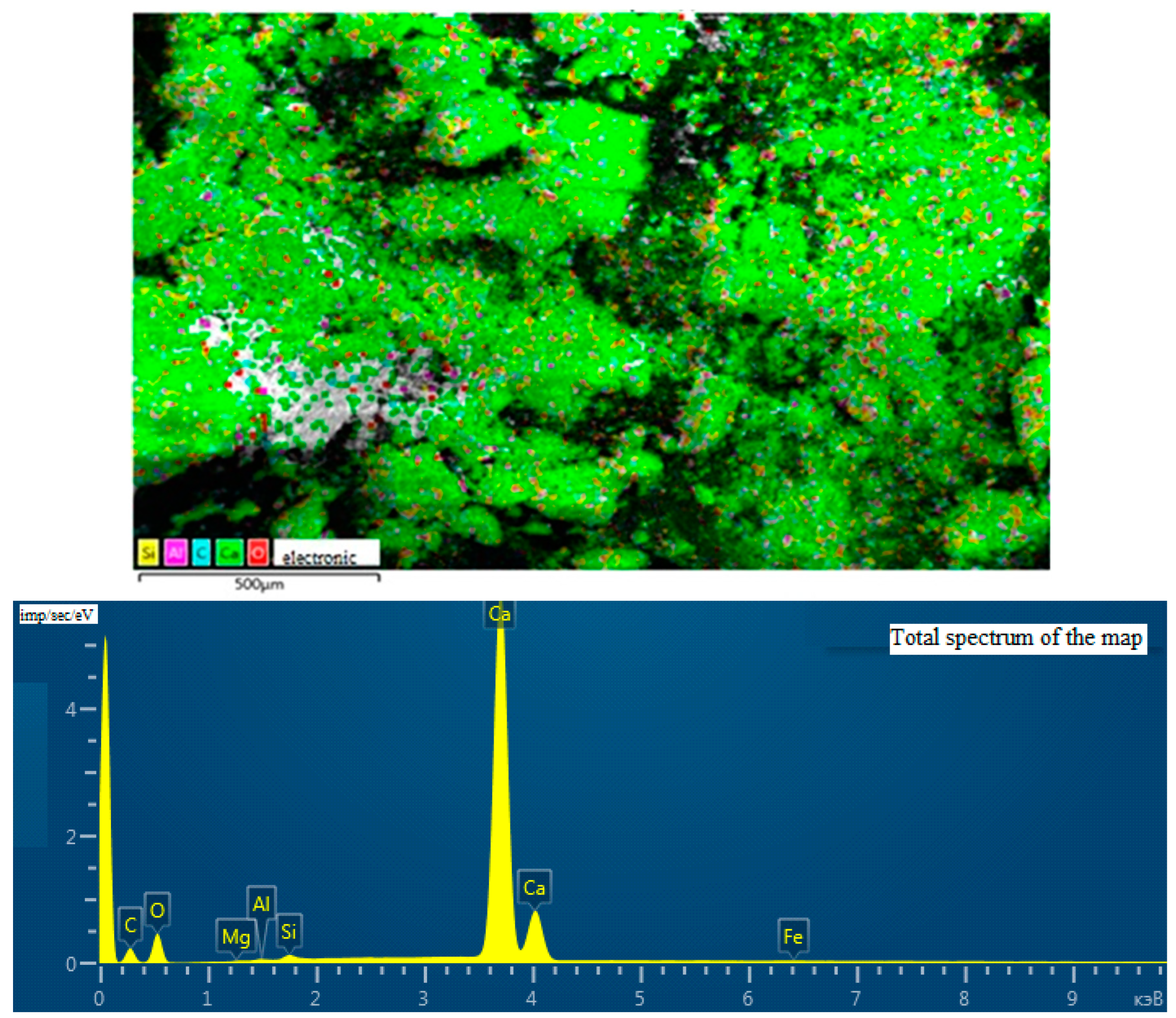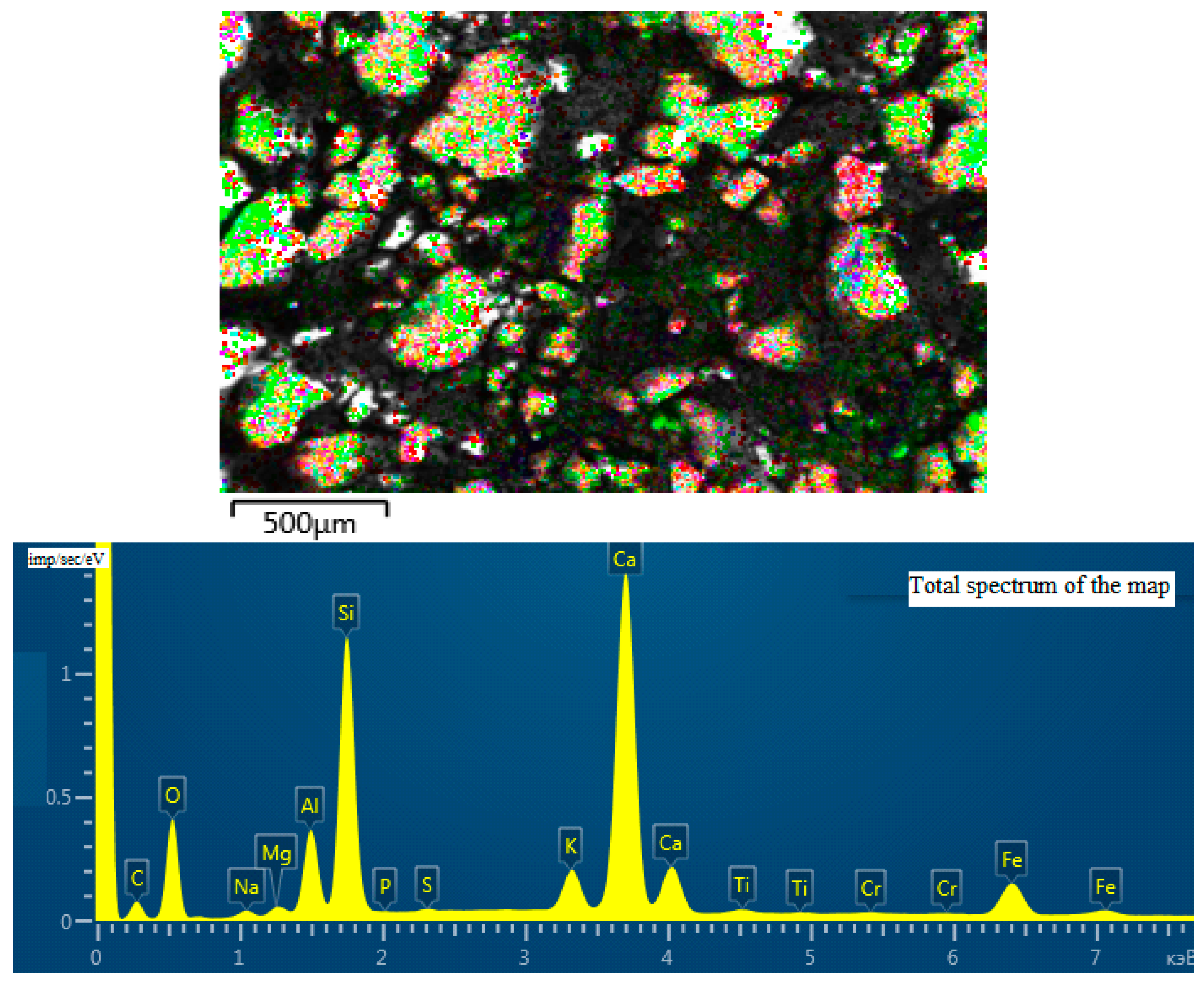1. Introduction
Organic farming is an intensively developing area of agricultural production that arose in response to serious problems caused by the development of a modern agroindustrial complex, the depletion of arable land, and the large-scale use of agrochemicals. This was a consequence of the emergence of environmental problems in farmlands and territories adjacent to them. Those problems lead to a decrease in the nutritional value of agricultural products and an increase in allergic and other diseases among the population. Organic farming’s objective is to provide the population with high-quality and safe agricultural products and preserve the environmental conditions of agrocenoses and adjacent territories. Organic farming is being developed in many countries around the world and is often seen as a sustainable alternative to intensive agricultural systems.
Organic farming is considered a way to achieve sustainability in a combination of environmental, economic, social, and other factors. Researchers answering the question of whether organic farming is sustainable study various indicators and their complexities. The most common idea is that an organic farming system should aid in maintaining a sufficient level of soil fertility for economical crop production in the long term, as well as protecting the environment so as to be considered sustainable [
1,
2]. To assess the ability of organic farming to be sustainable, some researchers analyze economic indicators [
3], such as household income [
4] and social factors [
5]. Significant indicators are crop yields [
6] and product quality [
6,
7]. The comparison of stability in the application of organic and inorganic fertilizers is considered in [
8,
9,
10,
11,
12]. Multifactorial meta-studies are also used [
6,
13,
14], where various indicators are analyzed in a complex. The methods of a comprehensive assessment of the environmental safety of organic agriculture are proposed in [
15]. It is also important to remember that one of the most important criteria for assessing the sustainability of the farming system is the preservation of soil fertility [
1,
2,
13,
16,
17,
18,
19,
20].
Soil stability is one of the main indicators of sustainability in organic farming [
21]. It determines the yield and economic efficiency of the farm. Moreover, it is related to the environmental sustainability of the farm territory.
It is rather useful to know what soil characteristics are being studied by scientists to assess the sustainability of organic farming. Fließbach et al. [
22] investigated microbial biomass and soil fractions by measuring size and density. As a result, it was discovered that the soils of organic and traditional agricultural systems differ in these indicators. The physical properties of soil samples in organic and traditional agriculture are considered in studies such as [
19]. Leifeld, J., who tried to answer the question about the sustainability of organic farming, studied the dynamics of organic matter content in soil [
13]. Nitrogen availability and carbon content in soil microbial biomass are considered in [
7]. Gosling et al. analyzed the content of the total organic matter, nitrogen, extracted potassium, and phosphorus in the soil and the ratio C:N [
1]. Gattinger et al. studied the carbon content in the upper soil layer and discovered that its accumulation occurs in organic farming [
16]. Anglade et al. reported on the study of the nitrate content in the surface layer of the soil [
23].
It is generally accepted that soil parameters such as pH, electrical conductivity, organic carbon content, total nitrogen, available forms of phosphorus, and potassium are mostly studied during the analysis [
17,
18]. In some cases, the list of studied indicators is wider. For instance, in the study [
20], in addition to those listed, the total sorption capacity of soils, the content of Mg, and microelements (B, Cu, Mn, and Zn) were analyzed. Thus, soil analysis is used to assess the balance of nutrients in the soil, organic matter, mobile forms of potassium, phosphorus, nitrogen, sulfur, and other macro- and microelements, as well as to prove the absence of undesirable impurities and toxic substances.
To analyze the stability of soil fertility in organic farming, it is important to consider the applied agricultural technologies, especially fertilizers. The impact of organic and inorganic fertilizers on soil conditions has been compared in many countries (India, Poland, Spain, Italy, USA, and many others) on various soils [
9,
10,
11,
12,
24,
25]. Fan et al. [
26] showed that the application of organic fertilizers, compared with the use of completely chemical fertilizers, allows increasing productivity by 3.48%, the content of the organic component—by 24.43%, total nitrogen—by 32.79%, total phosphorus—by 23.97%, total potassium—by 44.91%, mobile phosphorus—by 14.46%, mobile potassium—by 16.21%, soil bacteria—by 5.94%, ureases—by 22.32%, and catalases—by 17.68%. Consequently, the use of organic fertilizers instead of chemical ones makes it possible to improve the agroecological characteristics of the soil. In a study by Elkhlifi et al. [
27], when conducting scientific research on changes in the humus content in the soil before and after adding an organic component, it was noted that this indicator increased significantly. Similar results are given in the article by Dr. Lina Marija Butkevičienė [
28]. According to the data obtained by her, the humus content in the soil remained fairly stable or decreased slightly with the preservation of haulm and the use of single-component organic biostimulants Azofix, Ruinex, and Penergetic. On the contrary, when continuous straw application was combined with two- or three-component mixtures of these biological products or with compensatory nitrogen, the humus content increased. Compared with the initial state, this characteristic increased by 1.4–12.8% due to the complication of the formation conditions of microbiological biodiversity. Thus, previous studies show that there are effective organic farming technologies that contribute to improving soil conditions in certain territories. However, other researchers doubt the possibility of organic farming being sustainable and maintaining the balance of nutrients in the soil in the long term [
29].
Considering climatic conditions and soil types is important for the analysis of the stability of soil fertility in organic farming. Therefore, experiments with a wide range of geographical features and different agricultural crops are important. The data from scientific experiments with tomatoes, potatoes, rice, corn, carrots, and other agricultural crops are presented. Studies have been conducted in European countries [
1,
4,
14,
17,
22,
25,
30], in the Asian region [
2,
7,
8,
9,
10,
11], and in other parts of the world.
To characterize the stability of the system, the most important condition is long-term observation. The majority of previous studies analyze changes in soil parameters when using organic farming from 4 [
20] to 15 years [
1].
Due to the different opinions of the scientists, it is essential to see the conclusions made regarding the ability of organic farming to be sustainable, which are still conflicting. Connor, D. J., substantiates the point of view that organic farming will not be able to provide the world with food in the necessary quantities [
31]. Leifeld, J., is doubtful about the statement about the general sustainable use of soil resources in organic farming systems [
13]. Anup Das et al., on the contrary, insist on several advantages of organic farming for sustainable productivity and improvement in soil and product quality in the conditions of the eastern Himalayas [
7]. Gamage et al., based on research and arguments, claim that sustainable agriculture should provide enough products, as well as reduce the negative impact on the environment, and allow farmers to make a profit [
32]. There are conclusions about certain conditions or restrictions regulating the use of organic farming that remain sustainable. For example, in a study by Gosling et al. it is indicated that changes in organic management methods are necessary to increase the addition of potassium and phosphorus and avoid a decrease in soil fertility in the long term [
1]. There are reports on the use of integrated farming systems that combine traditional and ecological farming systems in order to increase sustainability [
33]. Niemiec, M., and co-authors report that organic farming can contribute to improving the physico-chemical, chemical, and biological properties of soils [
17]. A meta-analysis of European studies by Tuomisto et al. [
14] shows that organic farming can be considered as a way to increase sustainability in agriculture.
Since there is no definite answer to the question yet, it is sensible to continue research in this area. Undoubtedly, soil stability in organic farming with applied agricultural technologies should be considered in relation to their experience with soil and climatic conditions and cultivated crops. Therefore, for an objective assessment of soil stability in organic farming, it is very important to consider this issue in different territories with different types of soils and used agricultural technologies. Moreover, it is a necessary subject to a long-term experiment.
Such a large territory as Russia, with its diverse soil and climatic conditions, remains poorly studied in matters of organic farming, especially in long-term projections [
34]. The main document defining the development of organic agriculture in Russia, Federal Law №. 280 “On Organic Products and on Amendments to Certain Legislative Acts of the Russian Federation”, came into force in January 2020. Before that, there was no legislative or regulatory framework for the use of pesticides and agrochemicals, and there were no Russian standards for the quality of organic agricultural products. The adopted law and standards determined the official status of organic agriculture in Russia and stimulated its active development. In 2023, about 200 organic producers have already been accredited. To assess the sustainability of the organic farming system, it seems useful to analyze the soil indicators of one of the major agricultural producers implementing the ideas of organic farming over a long period (in some fields for 25 years and in most fields for 12 years).
Our study is a contribution to the study of the impact of long-term organic farming on agrochemical soil parameters. In addition to the traditionally studied soil parameters (soil organic matter, mobile phosphorus, exchangeable potassium, and pH), the data of the elemental analysis of the soil are considered.
The aim of this study is to assess the spatial variation in soil properties based on the analysis of their chemical composition, as well as the impact of long-term use of the organic cultivation method on the soil quality of an agricultural enterprise operating using organic farming technology for 12 years.
In accordance with the aims of the study, the following tasks were set: analysis of the content of exchangeable potassium, analysis of the content of mobile phosphorus, analysis of the content of soil organic matter, elemental analysis of soil samples, interpretation of the analysis results and creation of recommendations based on them, and comparison of the analysis results obtained in 2021 with the results of 2019 and 2017 in order to assess the long-term the effects of the organic method of cultivation on soil fertility.
2. Materials and Methods
The object of this study is the soil of the fields of an agricultural enterprise that has worked on the principles of organic farming for more than 12 years. The climate of the area is temperate. The climate zone is steppe. The soils are mainly carbonate black soils. Cereal grains (mainly winter wheat) and essential oil crops (lavender and sage) are grown in the fields (
Figure 1).
The basis of the crop nutrition system of the studied farm is the natural fertility of the land. The improvement in soil structure and the impact on changes in agrochemical parameters, primarily associated with the transfer of phosphorus to an accessible state, is carried out by adding organic residues using stubble destructors and immediately embedding them in the soil. In addition, leaf feeding is practiced during the growth period of plants with preparations approved by the certification organization “Organic”.
Observations, analyses, and records were performed according to generally accepted methods of field and laboratory research in soil science [
35] and Russian state standards (26205, 26213-84). The analysis of soil samples was conducted at the Educational and Scientific Center for Collective Use “Service Laboratory for Complex Analysis of Chemical Compounds” of the Russian State Agricultural Academy named after K.A. Timiryazev. The analysis of the content of exchangeable potassium and phosphorus was conducted in accordance with the Russian state standard 26205 [
36]. The method is based on the extraction of mobile phosphorus and potassium compounds from the soil with a 1% solution of ammonium carbonate and subsequent determination of phosphorus via spectrophotometry using a two-beam spectrophotometer of the UV-1900i brand (Shimadzu, Kyoto, Japan), and determination of potassium via flame photometry.
The amounts of soil organic matter were determined in compliance with the Russian state standard 26213-84 [
37] using the oxidative method with potassium dichromate in an acidic medium and subsequent measurement via spectrophotometry using a UV-1900i dual-beam spectrophotometer. The determination was made in soil samples from genetic horizons, which were immediately stored in air-tight and waterproof apparatus with sizes 3–1 mm, 1–0.5 mm, and 0.5–0.25 mm.
Electron microscopy studies of samples were conducted on a COXEM EM-30AX PLUS scanning electron microscope (COXEM Co., Ltd., Daejeon, Korea). The electron source was an electron gun with a thermionic emission type, SE detectors (to obtain an image with information about surface morphology), BSE (to obtain an image with information about composition variations based on contrast measured by atomic number), and EDS (for elemental analysis of the composition of samples). For spectral analysis of samples, spectra in the near-infrared region were taken using a SpectraStar 2600XT-R analyzer (VIKOMP, Moscow, Russia) with an In-Ga-As infrared radiation receiver and a base of reference standards; the spectra were processed using the InfoStart software package.
The elemental analysis was performed on a double-beam atomic absorption spectrometer AA-7000 (Shimadzu, Kyoto, Japan). The metal content was determined via atomic adsorption spectrometry (AAS) with electrothermal and flame atomization (Cu, Zn, Co, Ni, and Pb). The pH was determined using the potentiometric method in an extract of 1.0 M KCl and H2O. The experimental data were processed via mathematical statistics methods using Microsoft Office Excel and STATISTICA 6.0 software tools. The correlation dependence was evaluated according to the Fisher test.
3. Results
Based on the soil studies conducted in 2017–2021 to determine the concentrations of mobile phosphorus (
Figure 2) and potassium (
Figure 3), it was found that 80% of the soils of the farm fields have very low and low contents of mobile phosphorus (
Figure 2), with a sufficiently high content of potassium (
Figure 3).
3.1. Analysis of Mobile Phosphorus in Soils of the Studied Fields in 2017
We presented the results of the agrochemical analysis of the soils of the studied fields, which were obtained in 2017. It was claimed that of 423.6 ha of the explored areas, 100.8 ha (or 23.8%) has a content of mobile phosphates up to 11 mg/kg of soil; 236.3 ha (or 55.8%)—11–15 mg/kg of soil; 71.8 (or 17.0%)—16–30 mg/kg of soil; 3.0 ha (or 0.7%)—31–45 mg/kg of soil; 5.7 ha (or 1.3%)—46–60 mg/kg of soil; and 6 ha (or 1.4%)—more than 60 mg/kg of soil. The average value of mobile phosphorus is only 15 mg/kg of soil.
3.2. Analysis of Mobile Phosphorus in Soils of the Studied Fields in 2019
Considering the fact that the content of mobile forms of phosphorus calculated at P2O5 mg/kg of soil is accepted as very low at concentrations <10, low at 10–15, medium at 15–30, elevated at 30–45, high at 45–60, and very high at >60, according to the results of the conducted research in the fields, the content of mobile phosphorus is very low. Thus, on field № 4, where wheat is grown using organic farming technology, the concentration of mobile phosphorus in the soil is 7.5 mg/kg of soil, whereas in the field where traditional technology is used (field № 21), the concentration of mobile phosphorous is 4 mg/kg of soil. In fields № 175 and № 179, where lavender has been grown for 25 years, the content of mobile phosphorus is 6.5 and 7.5 mg/kg, respectively. For fields № 1 and № 100/2 with lavender grown since 2005, the phosphorus content is 1.5 and 2.0 mg/kg of soil, respectively.
3.3. Analysis of Mobile Phosphorus in Soils of the Studied Fields in 2021
As an example, the results of the determination of the mobile phosphorus concentration in field № 38 are presented below (
Figure 4).
It should be noted that the minimum value for mobile phosphate in soil samples from the farm fields was 1 mg/kg and the maximum value was 31 mg/kg, which confirms our 2019 and 2017 data indicating low content of mobile phosphorus in soil samples.
The results of the measurements of the mobile phosphorus content in the soils of the farm for the study period (2017–2021) are summarized in
Table 1. Graduation was carried out in accordance with the following boundaries: very low—less than 1.0 mg/100 g; low—1.0–1.5 mg/100 g; medium—1.5–3.0 mg/100 g; increased—3.0–4.5 mg/100 g; high—4.5–6.0 mg/100 g; and very high—more than 6.0 mg/100 g.
The value of the factor dispersion is less than the value of the residual dispersion; hence, there were no significant changes in the content of mobile phosphorus during the study period.
Thus, the soils of the studied fields have a very low content of mobile phosphorus, less than 10 mg/kg. From 2017 to 2021, despite the ongoing agricultural activities directed to phosphorus replenishment, there were no statistically significant changes. In some fields, there is a slight tendency toward a decrease in mobile phosphorus.
3.4. Analysis of Exchangeable Potassium in Soils in 2017
The results of the research in 2017 showed that of 423.6 ha of explored areas, 47.1 ha (or 11.1%) have exchangeable potassium content at 101–200 mg/kg of soil; 316.9 ha (or 74.8%)—201-300 mg/kg of soil; 44.9 (or 10.6%)—301–400 mg/kg of soil; 3.0 ha (or 0.7%)—401–600 mg/kg of soil; and 11.7 ha (or 2.8%)—more than 600 mg/kg of soil. The average value of exchangeable potassium content is 274 mg/kg of soil, the minimum value is 195 mg/kg of soil, and the maximum value is 322 mg/kg of soil.
3.5. Analysis of Exchangeable Potassium in Soils in 2019
The research and chemical analysis of exchangeable potassium in soils in 2019 confirmed the results of 2017. The content of exchangeable potassium in soils from the calculation of K2O mg/kg of soil is considered very low at a concentration < 55, low—at 55–100; medium—at 100–200; increased—at 200–300; high—at 300–400; and very high—at >400. According to the results of the conducted research on the fields, the content of exchangeable potassium is medium and increased.
3.6. Analysis of Exchangeable Potassium in Soils in 2021
The 2019 conclusions were confirmed by the 2021 results. As an example,
Figure 5 presents data on the content of exchangeable potassium (mg/kg) in the soil of field № 38.
The minimum value of this indicator for field № 38 is 215 mg/kg, and the maximum value is 335 mg/kg.
The results of the analysis of the content of exchangeable potassium are summarized in
Table 2. The statistical calculations are presented below. Gradation into groups: very low—less than 5.5 mg/100 g; low—5.5–100 mg/100 g; medium—10.0–20.0 mg/100 g; increased—20.0–30.0 mg/100 g; high—30.0–40.0 mg/100 g; and very high content of 40.0 mg/100 g.
The value of the factor dispersion is less than the value of the residual dispersion. Hence it was reliably established that there were no significant changes in the content of exchangeable potassium in the soils of the enterprise during the study period.
Thus, there is a sufficient content of exchangeable potassium in the soils in the studied fields. From 2017 to 2021, there are no trends toward a decrease in the potassium content in the soil in the studied fields.
3.7. Analysis of Organic Matter (Humus) Content in Soils in 2017
Last but not least, it is important to focus on another one of the main indicators in the assessment of soils—the content of organic matter. In 2017, it was found that of 423.6 hectares of explored areas on the content of organic matter, all of them have an organic matter concentration of more than 4.0%. The average value is 4.47%; the minimum value is 4.09%; and the maximum value is 5.64%.
3.8. Analysis of Organic Matter (Humus) Content in Soils in 2019
In the fields explored in 2019, we determined that the concentration of organic matter is 4.65 ± 0.34%. These data correlate with previously conducted studies, and soil fertility, determined by measuring organic matter concentration, has not decreased over the years.
3.9. Analysis of Organic Matter (Humus) Content in Soils in 2021
In 2021, our tests established organic matter concentrations for all organic farm fields. As an example,
Figure 6 shows the results for field № 38 (%).
It should be noted that for this field the indicator for organic matter content varies, as can be seen from the map. There are areas with humus content of more than 6%. On average, this indicator is 4.71 ± 0.32%.
The results of the analysis of the humus content for the study period are summarized in
Table 3. The distribution of data was carried out according to the following gradation: very low—less 2.0%; low—2.1–3.0%; medium—3.1–4.0%; increased—4.1–5.0%; high—5.1–6.0%; and very high >6.0%.
The value of the factor dispersion is less than the value of the residual dispersion; therefore, it can be concluded that there were no significant changes in the amount of organic matter during the study period.
Thus, based on soil studies conducted in 2017, 2019, and 2021 to determine the content of organic matter, it was claimed that the content of organic matter has not decreased. Therefore, it can be concluded that organic agrotechnologies used in organic farming agriculture do not deplete the reserves of organic matter in the soil.
3.10. Determination of pH of Soils of an Agricultural Enterprise
In 2019–2021 soil samples of different fields, it was found that their pH was in the range of 7.4–8.65. Thus, the soils of all studied fields have slightly alkaline reactions in the environment.
3.11. Investigation of Elemental Composition of Soil Samples
Figure 7 shows the results of the elemental analysis of soil samples from field № 63 (fraction less than 0.5 mm).
As noted earlier, the soil contains high concentrations of potassium that is quite easily transformed into exchangeable form. Concentrations greater than 0.1% contain non-metals—carbon, oxygen, and silicon, which are incorporated into silicates or silicon dioxide, carbonates, and metal oxides.
Figure 8 shows a distribution map of calcium and aluminum in the same field, and
Figure 9 shows iron and titanium.
Among the metals in concentrations of more than 0.1% are manganese, titanium, magnesium, potassium, aluminum, iron, and calcium; high concentrations of these and other metals can determine the alkaline reaction of the soil.
It should also be noted that in large fractions of soil particles of 1–2 and 2–7 mm in size, the main component is calcium carbonate, as it follows from
Figure 10. The ratio between oxygen, carbon, and calcium definitely indicates the presence of calcium carbonate.
It is important to emphasize that the obtained data confirm the fact that the application of organic farming technology affects the content of macro- and microelements in the soil. Comparative elemental analysis of samples of the same particle size shows that the concentration of carbon (included in the organic matter, not in the composition of carbonates) is 2–3 times higher in the “organic” technology than in traditional cultivation. At the same time, the concentration of silicon is 2.5 times lower in the “organic” technology, calcium is 1.5 times lower, and iron and aluminum are 1.7 times lower than in traditional technologies.
These results are confirmed if we analyze the mineral component of soil after annealing at 950 °C. The results of the elemental analysis of soil after the deletion of organic components via incineration are presented in
Figure 11.
As it follows from the microphotographs of
Figure 11 and the correlation between chemical elements, the mineral part of the soil is represented by carbonates, silicates of calcium, iron, aluminum, magnesium, sodium, chromium, titanium, and their oxides. These results draw attention to the fact that the mineral part has a low content of phosphorus and sulfur.
Thus, soils of the studied fields are represented by a variety of chemical elements, with a predominance of carbonates and silicates (silicon oxide), but an insufficiently balanced composition, especially for phosphorus and sulfur. To optimize the ratios and contents of components in the soil, it is necessary to carry out appropriate agrochemical measures.
5. Conclusions
Soil samples were analyzed on carbonate black soils of the farm during the assessment of soil fertility based on the following parameters: pH, humus, exchangeable potassium, mobile phosphorus, and macro- and microelements. Soil maps of fields were compiled. It is noted that the humus content in the fields of the farm is quite high—up to 4.5%. Additionally, long-term studies show that with the organic method of cultivating the land, this indicator does not decrease. This indicates the beneficial impact of organic farming on the content of organic matter in the soil. For all fields, the pH indicator has a slightly alkaline reaction. The metals present in concentrations of more than 0.1% are manganese, titanium, magnesium, potassium, aluminum, iron, and calcium; high concentrations of these metals can determine the alkaline reaction.
The main problem that the farm needs to solve in terms of mineral composition is that the soils have a very low content of mobile phosphorus. From 2017 to 2021, no significant changes in the content of mobile phosphorus were found. The replenishment of phosphorus in the composition of soils is recommended. Studies of the content of exchangeable potassium in soils have shown that its concentration is characterized as medium in the fields of the farm. There is no downward trend during the study period.
This study made it possible to continue monitoring the state of the ecological and chemical indicators of the soils of an agricultural enterprise in order to assess the impact of the organic farming method on soil fertility. The low phosphorus content in the fields of the farm was confirmed and no significant changes were found during the study period. A number of recommendations are given for replenishing the phosphorus content that are suitable for organic farming standards. According to other indicators, it was found that there were no deficiencies in substances or trends toward their decrease, which makes it possible to consider that the applied agrotechnologies provide replenishment of the mineral and organic matter of soils.
We plan to continue exploring the ability of organic farming agrotechnologies to be sustainable. To undertake this, we will continue monitoring the chemical and ecological indicators of the soils of this farm in order to study the effect of organic cultivation technology on the ability of soils to self-heal and replenish minerals and organic substances. In addition, further attention should be paid to assessing the impact of the effects of the application of organic farming technology recommended to farms of agricultural enterprises.
